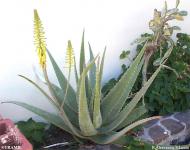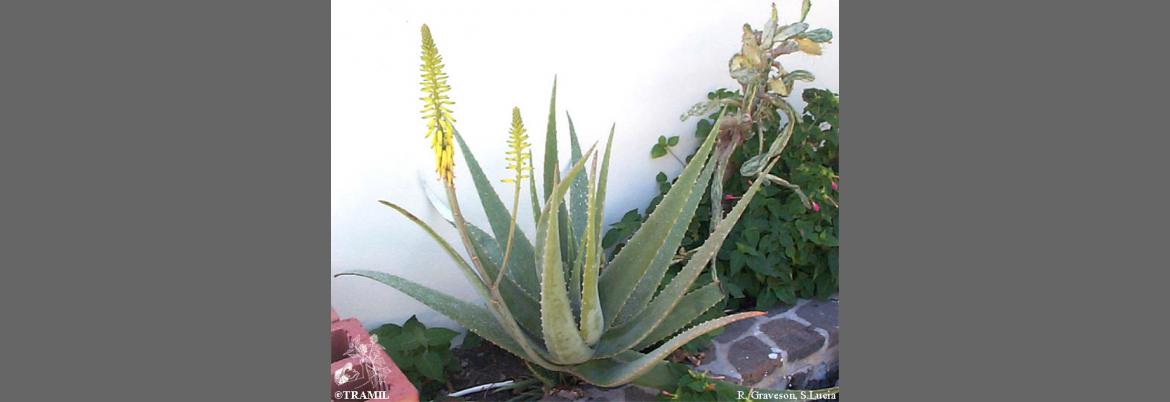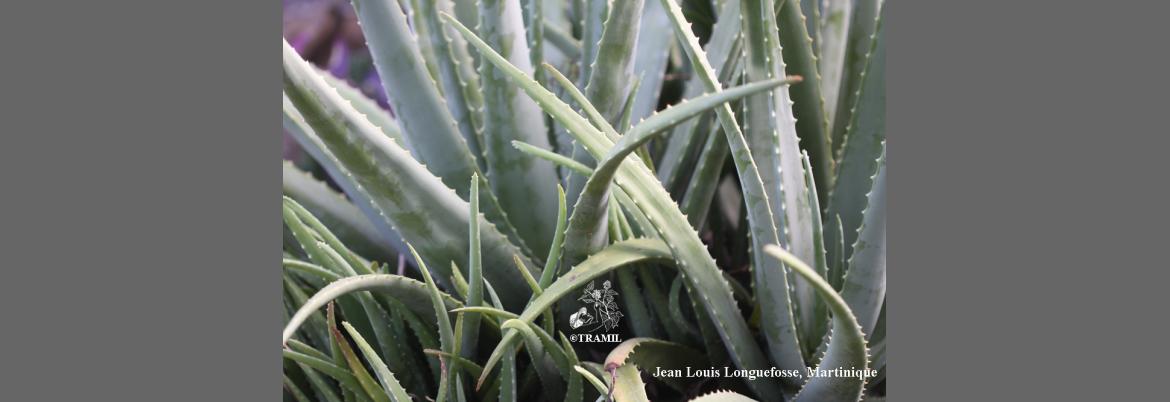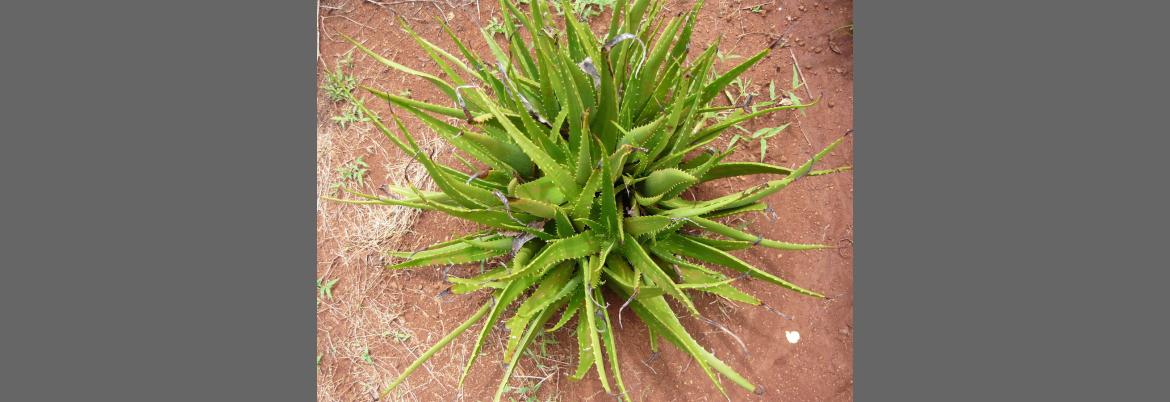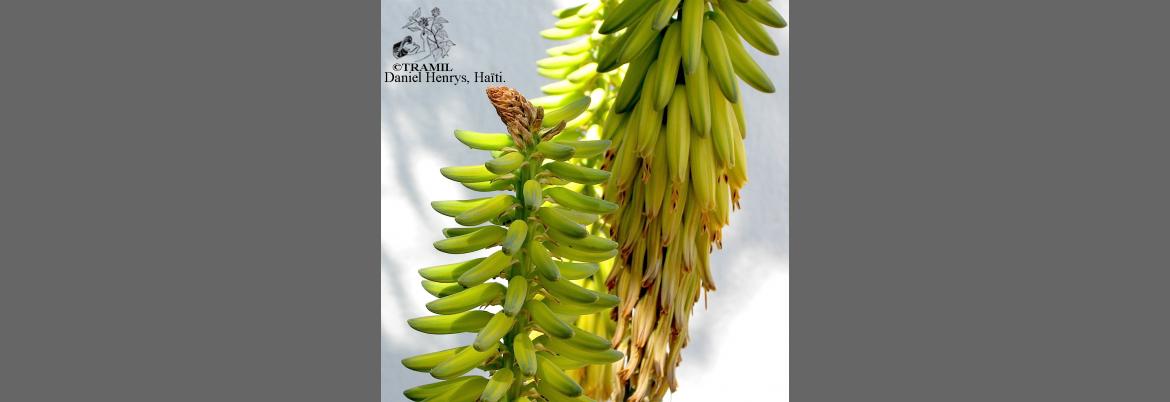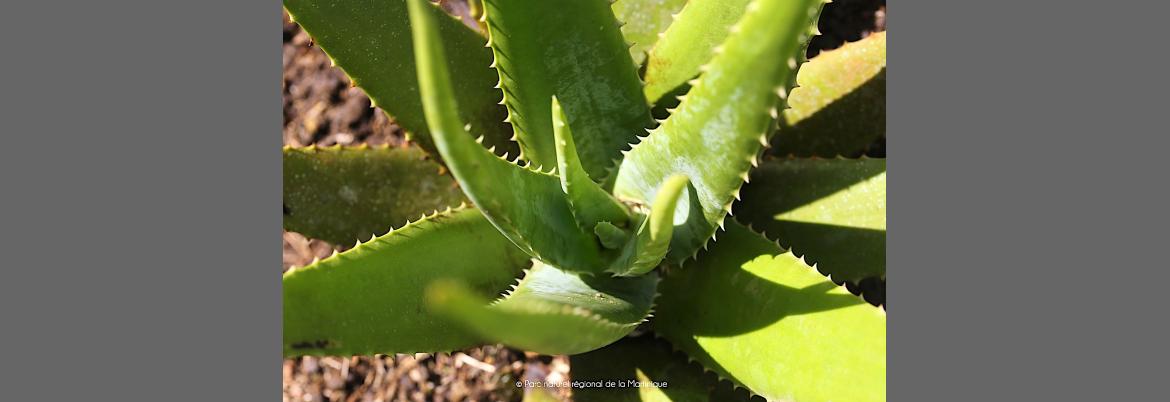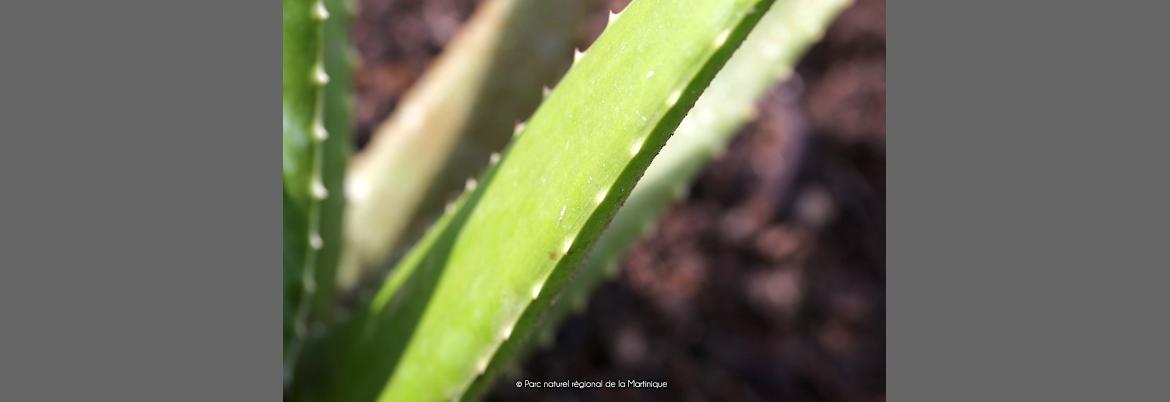1 BENEDETTI MD, 1994
Encuesta TRAMIL. Universidad de Puerto Rico, Mayagüez, Puerto Rico.
2 FAUJOUR A, MURREY D, CHELTENHAM-CORBIN B, CARRINGTON S, 2003
TRAMIL survey. enda-caribbean, IICA & UAG, Saint Thomas, Barbados.
3 DELAIGUE J, 2005
TRAMIL survey. UAG & PRDI, Tobago House of Assembly, Scarborough, Tobago.
4 YAMAGUCHI I, MEGA N, SANADA H, 1993
Components of the gel of Aloe vera (L.) Burm. f. Biosci Biotech Biochem57(8):1350-1352.
5 GOWDA DC, NEELISIDDAIAH B, ANJANEYALU YV, 1979
Structural studies of polysaccharides from Aloe vera. Carbohydr Res72:201-205.
6 MANDAL G, DAS A, 1980b
Structure of the glucomannan isolated from the leaves of Aloe barbadensis Miller. Carbohydr Res 87:249-256.
7 MANDAL G, GHOSH R, DAS A, 1984
Characterization of the polysaccharides of Aloe barbadensis Miller: part III. Structure of a acidic oligosaccharide. Indian J Chem Ser B22:890-893.
8 HAQ N, HANNAN A, 1981
Studies on glucogalactomannan from the leaves of Aloe vera Tourn. (ex Linn.). Bangladesh J Scient & Ind Res16:68-72.
9 HART LA, VAN DER BERG AJJ, KUIS L, VAN DIJK H, LABADIE RP, 1989
An anti-complementary polysaccharide with immunological adjuvant activity from the leaf parenchyma cells of Aloe vera. Planta Med 55(6):509-512.
10 McANALLEY BH, 1988
Process for preparation of Aloe products, produced thereby and composition thereof. Patent - USA: 4,735,935
11 MANNA S, McANALLEY BH, 1993
Determination of the position of the O acetyl group in a b(1®4) mannan (acemannan) from Aloe barbadensis Miller. Carbohydr Res 241:317-319.
12 YAMAGUCHI I, MEGA N, SANADA H, 1993
Components of the gel of Aloe vera (L.) Burm.F. Bioscience, Biotechnology, Biochemistry57:1350-1352.
13 MARY NY, CHRISTENSEN BV, BEAL JL, 1956
A paper chromatographic study of Aloe, aloin and cascara sagrada. J Am Pharm Assoc Sci Ed 45:229-232.
14 HOLDSWORTH DK, 1971
Chromones in Aloe species. Part I. Aloesin-A C-glucosyl-7-hydroxychromone. Planta Med 19:322-325.
15 PASZKIEWICZ-GADEK A, CHLABICZ J, GALASINSKI W, 1988
The influence of selected potential oncostatics of plant origin on the protein biosynthesis in vitro. Pol J Pharmacol Pharm 40(2):183-190.
16 RAUWALD H, 1987
New hydroxyaloins: the periodate-positive substance from cape aloes and cinnamoyl esters from Curacao aloes. Pharm Weekbl (Sci Ed) 9(4):215.
17 ZWAVING JH, ELEMA ET, 1976
A comparative investigation of two methods for the determination of 1,8-dihydroxyanthracene derivatives in vegetable drugs. Pharm Weekbl (Sci Ed) 111:1315.
18 WALLER GR, MANGIAFICO S, RITCHEY CR, 1978
A chemical investigation of Aloe barbadensis. Proc Okla Acad Sci58:69.
19 WALLER GR, MANGIAFICO S, RITCHEY CR, CUMBERLAND CD, 1978
Natural products from Aloe barbadensis Miller. Lloydia41:648A.
20 SUGA T, HIRATA T, 1983
The efficacy of the Aloe plants chemical constituents and biological activities. Cosmet Toiletries98(6):105-108.
21 MUKERJI B, 1953
The Indian pharmaceutical codex. Volume I - Indigenous drugs. New Delhi, India: Council of Scientific and Industrial Research.
22 MANDAL G, DAS A, 1980
Characterization of the polysaccharides of Aloe barbadensis Miller. part I. Structure of the D-galacatan isolated from Aloe barbadensis Miller. Carbohydr Res86:247-257.
23 MANDAL G, DAS A, 1980
Characterization of the polysaccharides of Aloe barbadensis Miller. part II. Structure of the glucomannan isolated from the leaves of Aloe barbadensis Miller. Carbohydr Res 87:249-256.
24 GUARDARRAMA I, HERNANDEZ M, DIAZ-ACOSTA A, CARBALLO A, 1993
Observaciones clínicas sobre el efecto delAloe barbadensis L. en el tratamiento de pacientes asmáticos. Estudio preliminar. Informe TRAMIL. Instituto Superior de Ciencias Médicas, Santa Clara, Cuba.TRAMIL VI, Basse Terre,Guadeloupe, UAG/enda-caribe.
25GUARDARRAMA I, TORRES ORLANDO, HERNANDEZ M, RUIZ MM, GOMEZ M, CLAVO Y, 1994
Prueba de hiperreactividad bronquial a la carbacolina en pacientes asmáticos tratados con Aloe barbadensis. Medicentro 10(1):93-101.
26 RAINE TJ, LONDON MD, GOLUCH L, HEGGERS JP, ROBSON MC, 1980
Antiprostagladins and antithromboxanes for treatment of frostbite. American College of Surgeons 1980 Surgical Forum31:557-559.
27MARTINEZ MJ, BETANCOURT J, ALONSO N, 1996
Ausencia de actividad antimicrobiana de un extracto acuoso liofilizado de Aloe vera (sábila). Rev Cubana Plantas Med 1(3):18-20.
28 GOTTSHALL RY, LUCAS E, LICKFELDT A, ROBERTS J, 1949
The occurrence of antibacterial substances active against Mycobacterium tuberculosis in seed plants. J Clin Invest 28:920-923.
29 CACERES A, GIRON L, ALVARADO SR, TORRES MF, 1987
Screening of antimicrobial activity of plants popularly used in Guatemala for the treatment of dermatomucosal diseases. J Ethnopharmacol20(3):223-237.
30 BUNYAPRAPHATSARA N, JIRAKULCAIWONG S, THIRAWARAPAN S, MANONUKUL J, 1996
The efficacy of Aloe vera cream in the treatment of first, second and third degree burns in mice. Phytomedicine2(3):247-251.
31 ROWE TD, LOVELL BK, PARKS LM, 1941
Further observations on the use of Aloe vera leaf in the treatment of third degree X-ray reactions. J Am Pharm Assoc Sci Ed30:266-269.
32 DAVIS RH, LEITNER MG, RUSSO JM, BYRNE ME, 1989
Wound healing. Oral and topical activity of Aloe vera. J Am Podiatr Med Assoc 79(11):559-562.
33 DAVIS RH, DONATO J, HARTMAN G, HAAS R, 1994
Anti-inflammatory and wound healing activity of a growth substance in Aloe vera. J Am Podiatr Med Assoc84(2):77-81.
34 DAVIS RH, AGNEW PS, SHAPIRO E, 1986
Antiarthritic activity of anthraquinones found in Aloe for podiatric medicine. J Am Podiatr Med Assoc76:61-66.
35 MOHSIN A, SHAH AH, AL-YAHYA MA, TARIQ M, TANIRA MO, AGEEL AM, 1989
Analgesic antipyretic activity and phytochemical screening of some plants used in traditional Arab system of medicine. Fitoterapia 60(2):174-177.
36FURONES JA, MORON FJ, PINEDO Z, 1996
Acción analgésica de un extracto acuoso liofilizado de Aloe vera L. en ratones. Rev Cubana Plantas Med 1(2):15-17.
37 STRICKLAND FM, PELLEY RP, KRIPKE ML, 1994
Prevention of ultraviolet radiation-induced suppression of contact and delayed hypersensitivity by Aloe barbadensis gel extracts. J Invest Dermatol102(2):197-204.
38 ROMAN-RAMOS R, FLORES-SAENZ JL, PARTIDA-HERNANDEZ G, LARA-LEMUS A, ALARCON-AGUILAR F, 1991
Experimental study of hypoglycemic activity of some antidiabetic plants. Arch Invest Med22(1):87-93.
39 DAVIS RH, LEITNER MG, RUSSO JM, 1987
Topical anti-inflammatory activity of Aloe vera as measured by ear swelling. J Am Podiatr Med Assoc 77(11):610-612.
40 DAVIS RH, LEITNER MG, RUSSO JM, 1988
Aloe vera. A natural approach for treating wounds, edema and pain in diabetes. J Am Podiatr Med Assoc78(2):60-68.
41 DAVIS RH, KABBANI JM, MARO NP, 1986
Wound healing and antiinflammatory activity of Aloe vera. Proceedings of the Pennsylvania Academy of Sciences60:79.
42 DAVIS RH, LEITNER MG, RUSSO JM, MARO NP, 1987c
Biological activity of Aloe vera. Med Sci Res15:235.
43 RODRIGUEZ-BIGAS M, CRUZ NI, SUÁREZ A, 1988
Comparative evaluation of Aloe vera in the management of burn wounds in guinea pigs. Plast Reconstr Surg81:386-389.
44 KIVETT WF, 1989
Aloe vera for burns. Plastic and Reconstructive Surgery 83:195.
45 CARBAJAL D, CASACO A, ARRUZAZABALA L, GONZALEZ R, FUENTES V, 1991
Pharmacological screening of plant decoctions commonly used in Cuban folk medicine. J Ethnopharmacol33(1/2):21-24.
46 DAVIS RH, DI DONATO JJ, JOHNSON RW, STEWART CB, 1994
Aloe vera, hydrocortisone, and sterol influence on wound tensile strength and anti-inflammation. J Am Podiatr Med Assoc84.(12):614-621.
47 LUSHBAUGH CC, HALE DB, 1953
Experimental acute radiodermatitis following beta irradiation. V. Histopathological study of the mode of action of therapy with Aloe vera. Cancer 6:690-698.
48 ROVATTI B, BRENNAN RJ, 1959
Experimental thermal burns. Induct Med Surg 28:364.
49 NORTHWAY RB, 1975
Experimental use of Aloe vera extract in clinical practice. Vet Med Small Animal Clinic70:80.
50 COBBLE HH, 1975
Stabilized Aloe vera gel. Patent - USA: 3,892,853.
51 FULTON JE, 1990
The stimulation of postdermabrasion wound healing with stabilized Aloe vera gel-polyethylene oxide dressing. J Dermatol Surg Oncol16(5):460-467.
52 YAGI A, SHIDA T, NISHIMURA H, 1987
Effect of amino acids in Aloe extract on phagocytosis by peripheral neutrophil in adult bronchial asthma. Jap J Allergol36(12):1094-1101.
53 KAVOUSSI H, KAVOUSSI HP, 1993
Saturated solution of purified sodium chloride in purified Aloe vera for inducing and stimulating hair growth and for decreasing hair loss. Patent - USA: 5,215,760.
54LEONJE, ROSALES V, ROSALES RA, PAVON V, 1999
Actividad antiinflamatoria y cicatrizante del ungüento rectal de Aloe vera L (sábila). Rev Cubana Plantas Med 4(3):106-109.
55 VISUTHIKOSOL V, CHOWCHUEN B, SUKWANARAT Y, SRIURAIRATANA S, BOONPUCKNAVIG V, 1995
Effect of Aloe vera gel to healing of burn wound a clinical and histologic study. J Med Assoc Thai 78(8):403-409.
56 CREWE JE, 1939
Aloes in the treatment of burns and scalds. Minnesota Med22:538-539.
57 SYED T, AHMAD S, HOLT A, AHMAD S, AHMAD S, AFZAL M, 1996
Management of psoriasis with Aloe vera extract in a hydrophilic cream: a placebo-controlled, double-blind study. Trop Med Int Health 1(4):505-509.
58 SYDISKIA RJ, OWEN DG, 1987
Aloe emodin and other anthraquinones and anthraquinone-like compounds from plants virucidal against Herpes simplex viruses. Patent - USA: 4,670,265.
59RAMOS A, EDREIRA AYMEE, VILLESCUSA A, VIZOZO A, MARTINEZ MJ, 1996
Evaluación genotóxica de un extracto acuoso de Aloe vera L. Rev Cubana Plantas Med 1(2):18-23.
60 VIZOSO A, RAMOS A, GARCIA A, PILOTO J, PAVON V, 2000
Estudio genotóxico in vitro e in vivo del extracto fluido de Cassia grandis L. y el gel de Aloe vera L. Rev Cubana Plantas Med 5(3):91-96.
61 DHAR ML, DHAR MM, DHAWAN B, MEHROTRA B, RAY C, 1968
Screening of Indian plants for biological activity. Part I. Indian J Exp Biol6:232-247.
62 BHAKUNI D, DHAR ML, DHAR MM, DHAWAN BN, GUPTA B, SRIMALI RC, 1971
Screening of Indian plants for biological activity. Part III. Indian J Exp Biol9:91.
63 SHAH AH, QURESHI S, TARIQU M, AGEEL AM, 1989
Toxicity studies on six plants used in the traditional Arab system of medicine. Phytother Res3(1):25-29.
64 YOKEL R, OGZEWALLA C, 1981
Effects of plants ingestion in rats determined by the conditioned taste aversion procedure. Toxicon19(2):223-232.
65 PRAKASH A, MATHUR R, 1976
Screening of Indian plant for antifertility activity. Indian J Exp Biol 14:623-626.
66 SETHI N, NATH D, SING R, 1989
Teratological evaluation of some commonly used indigenous antifertility plants in rats. Int J Crude Drug Res27(2):118-120.
67 MORROW DM, RAPAPORT MJ, STRICK RA, 1980
Hypersensitivity to Aloe. Archives of Dermatology 116:1064-1065.
68 PARRA AL, YHEBRA RS, SARDINAS IG, BUELA LI, 2001
Comparative study of the assay of Artemia salina L. and the estimate of the medium lethal dose (LD50 value) in mice, to determine oral acute toxicity of plant extracts. Phytomedicine 8(5):395-400.
69 Zambrano LE, 2007
Encuesta TRAMIL en Guareguare, Miranda. UCV, Caracas, Venezuela.
70 BALZ E, BOYER A, BURAUD M, 2007
Enquête TRAMIL à Marie-Galante. U. Bordeaux 3, U. Paris XI Chatenay-Malabry, UAG, Guadeloupe.
